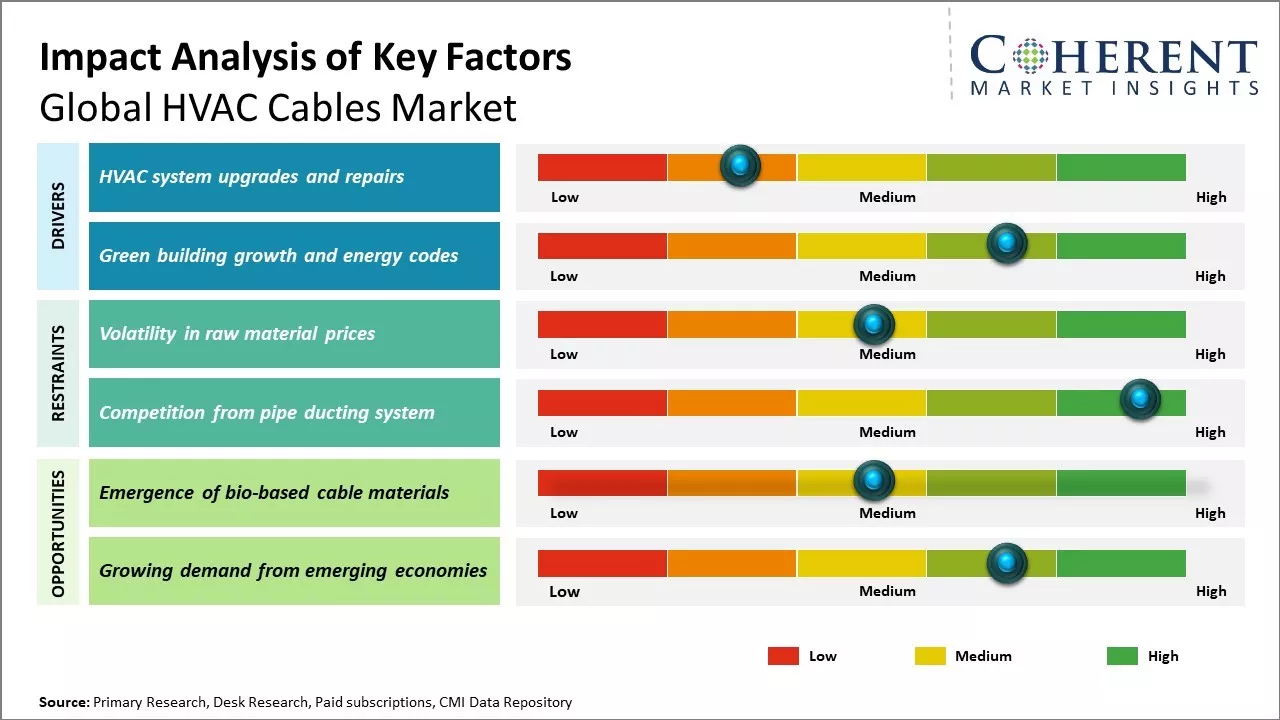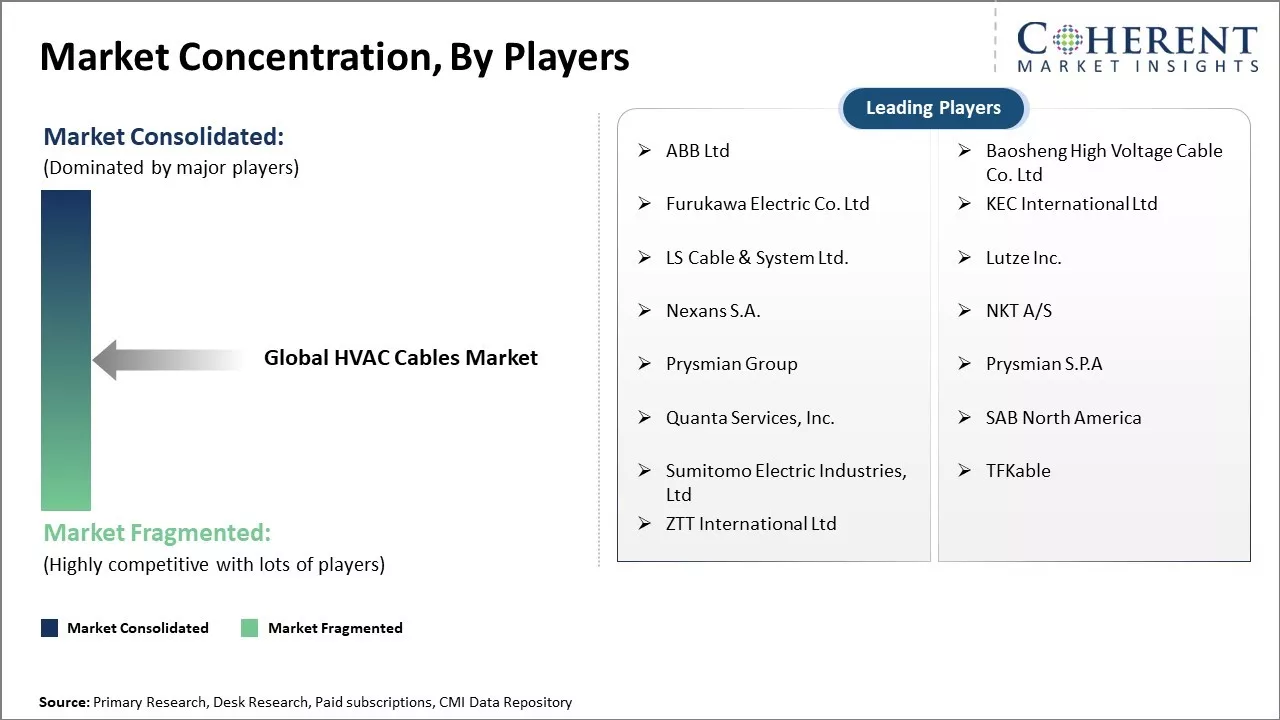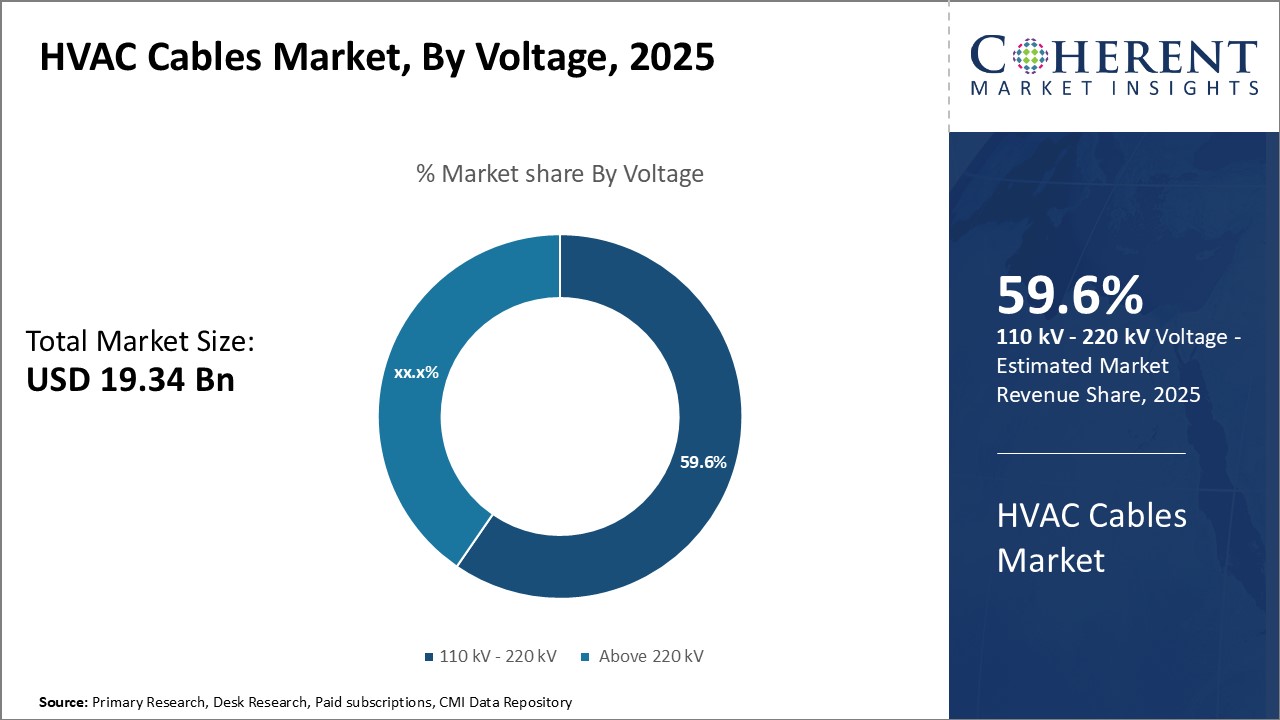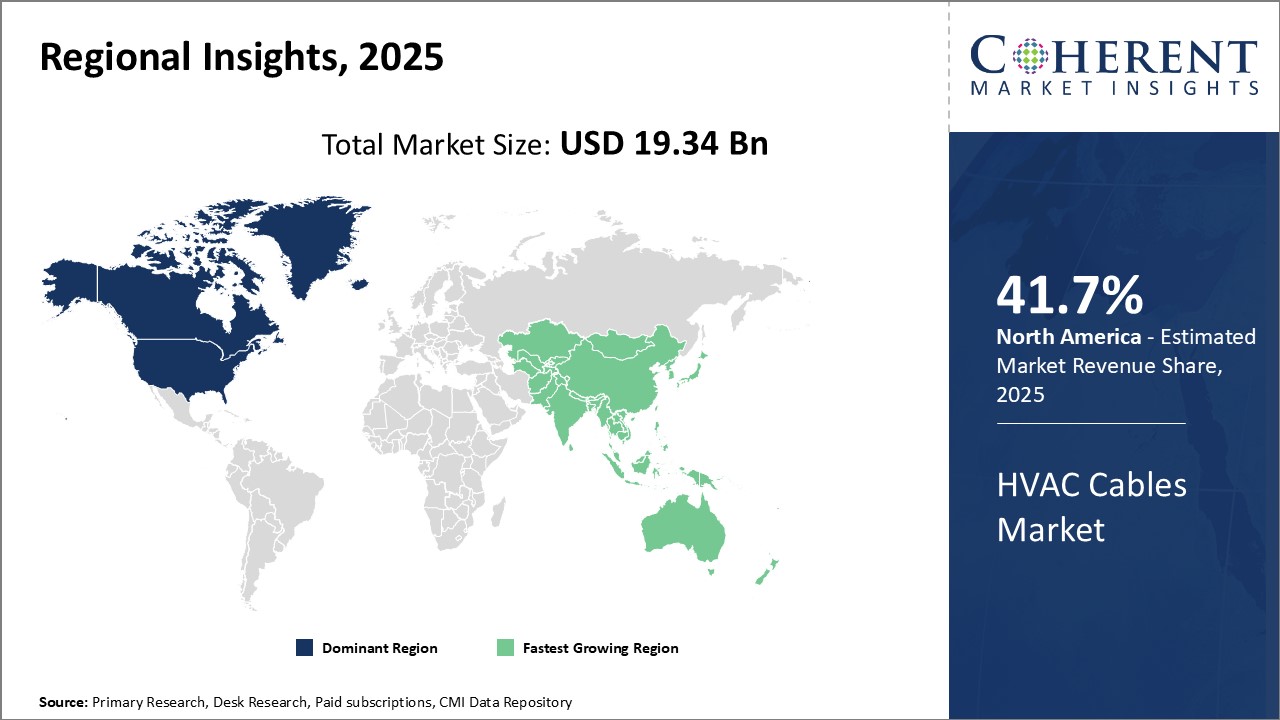HVAC Cables Market Size and Trends
The Global HVAC Cables Market is estimated to be valued at US$ 19.34 Bn in 2025 and is expected to reach US$ 30.46 Bn by 2032, exhibiting a compound annual growth rate (CAGR) of 6.7% from 2025 to 2032.

Discover market dynamics shaping the industry: Download Free Sample
Rapid growth in commercial and residential construction activities across developing nations such as India, China, and other Asian countries is expected to drive the demand for HVAC cables during the forecast period.
Increasing demand for energy efficient and eco-friendly cooling and heating systems is expected to support the growth of the global HVAC cables market during the forecast period. Stringent regulations regarding emission levels from various countries is further expected to propel the demand for HVAC cables.
HVAC system upgrades and repairs
As HVAC systems across commercial and residential properties age, the demand for system upgrades and repairs is increasing. Many HVAC systems installed 5-10 years ago are nearing the end of their useful lifespan and require modernization to improve efficiency and functionality. This presents a major opportunity for HVAC cable suppliers as outdated wiring often must be replaced. Properties with older HVAC units are recognizing the long-term cost savings of upgrading to new high-performance systems that integrate smart technologies and meet current energy codes. Repairing or replacing deteriorating cables is a necessary part of any HVAC system retrofit or replacement project. The growing installed base of aging HVAC equipment essentially guarantees steady demand for HVAC cables into the future as facilities keep existing systems operational through repairs and periodic replacements. Many owners are also taking advantage of HVAC retrofits to install building management systems that require new low-voltage cables for advanced controls and connectivity.
Market Concentration and Competitive Landscape

Get actionable strategies to beat competition: Download Free Sample
Green building growth and energy codes
Sustainability initiatives and stricter energy efficiency codes are driving increased HVAC cable demand. More construction projects are pursuing green building certifications that mandate the use of energy-efficient HVAC technologies. This often involves installing complex controls networks and integrated systems that rely on low-voltage wiring. At the same time, baseline energy codes for new buildings and major remodels have gotten substantially more stringent in recent cycles. Meeting current requirements generally demands HVAC equipment and design upgrades, which translate to greater cable needs. Contractors report installing 30-50% more cable in new projects versus a decade ago. Governments are also providing incentives for HVAC replacements and retro-commissioning projects targeting aged commercial and public buildings. More rigorous compliance testing under revised codes further boosts cable usage. As sustainability remains a key priority and codes evolve to reduce carbon footprints, the green building trend and regulatory changes are projected to lift HVAC cable consumption substantially in the coming years.
Key Takeaways from Analyst:
The increasing construction of residential and commercial buildings worldwide will be a key driver for market growth. Nations in Asia Pacific and the Middle East will see high demand due to ongoing infrastructure development projects.
Key factors like urbanization, rising disposable incomes, and changing lifestyles are leading to higher demand for centralized air conditioning systems in both developed and developing economies. This will augment demand for HVAC cables globally. However, fluctuating raw material prices may impact the manufacturing cost of cables and act as a restraint.
Germany, the U.S., China, Japan, and India currently dominate the HVAC cables market owing to their large industrial and construction bases. Meanwhile, Southeast Asian countries are emerging as high-potential markets.
Moving forward, product innovation and development of halogen-free and fire-resistant cables should open new opportunities. Adoption of renewable energy technologies like geothermal heating may also spur cable requirements.
In summary, demand from new building projects and retrofits along with shift towards eco-friendly solutions will support steady expansion of the global HVAC cables market over the next decade. Ongoing infrastructure development in Asia Pacific and Middle East creates substantial prospects, making these important regions to watch.
Market Challenges: Volatility in raw material prices
The global HVAC cables market has been witnessing considerable volatility in the prices of key raw materials over the past couple of years. Fluctuations in the prices of metals like copper and aluminum that are extensively used in manufacturing HVAC cables have negatively impacted the growth trajectory of this market. Copper prices especially have seen sharp swings, rising from USD 7,500 per tonne in 2020 to over US$ 10,000 per tonne in 2021 owing to supply constraints and high demand from China. This rise in copper prices increased the manufacturing cost of HVAC cables substantially. As HVAC cable producers could only pass on a portion of this hike to consumers, margins shrunk significantly.
Market Opportunities: Emergence of bio-based cable materials
The emergence of bio-based cable materials offers tremendous opportunities for growth in the global HVAC cables market. Bio-based polymers synthesized from natural and renewable resources like lignin, cellulose or vegetable oils are increasingly being used as substitutes for traditional petroleum-based cable insulation and jacket materials. Some of the key advantages of bio-based cable materials include enhanced sustainability, reduced environmental footprint, and improved recyclability.
Bio-based cable materials allow manufacturers to provide more eco-friendly and sustainable product offerings that meet the rising demand for green and renewable solutions.

Discover high revenue pocket segments and roadmap to it: Download Free Sample
Insights By Voltage - Growing Infrastructure Development Drives Demand for 110 kV – 220 kV Cables
The 110 kV - 220 kV voltage segment is estimated to account for 59.6% share of the global HVAC cables market in 2025 due to increasing infrastructure development activities worldwide. Cables within this voltage range are ideal for transmitting electricity over medium distances for both residential and commercial applications. They allow reliable power transmission while keeping distribution costs minimal.
Rapid urbanization and the expansion of existing cities have significantly boosted infrastructure spending on commercial complexes, housing developments, and public utilities. Developing regions in the Asia Pacific and Latin America are particularly experiencing a major construction boom, driving the demand for efficient electricity distribution cables. The widespread adoption of these cables for internal wiring enables the electrification of entire developments in a single step.
Public sector investment in strengthening national transmission grids is another crucial factor. Many governments are focused on ensuring reliable and affordable electricity access, even in remote or rural areas, which has prompted grid interconnection and capacity addition initiatives involving lines within the 110-220 kV range. Additionally, the renovation of aging power infrastructure in developed markets involves replacing cables prone to faults or unable to support growing load requirements.
Overall, as infrastructure spending maintains its momentum globally, especially in emerging nations, medium-voltage cables will continue to enjoy strong uptake to effectively wire both public and private construction ventures. Their reliable performance and cost advantages make them well-suited for extensive power transmission needs arising from infrastructural development activities worldwide.
Insights By Category - Extensive Network Coverage Drives Demand for Overhead Cables
The overhead segment is estimated to capture 43.6% share of the global HVAC cables market in 2025 owing to its widespread usage for transmitting electricity over long distances. Overhead lines allow utilities to span long aerial routes while keeping initial installation costs relatively lower than other methods.
Overhead power lines remain the most cost-effective solution for establishing new transmission corridors and upgrading existing electricity networks, especially in developing countries focused on expanding rural electrification. Compared to other cable types like submarine or underground, overhead lines incur minimal expenses related to burying or trenching, making them highly practical for covering vast geographic territories.
Overhead cables also face fewer restrictions in terms of maximum voltage capacity or environmental impact, enabling them to transmit bulk electricity generated from utilities over long-haul routes spanning hundreds of miles. They can carry heavier load requirements, making them well-suited for the backbones of nationwide power grids.
This widespread utilization of overhead lines will continue supporting the segment's leadership position. Besides expanding rural coverage, ongoing renewable energy integration and inter-state/inter-grid connectivity projects rely heavily on this cost-efficient cable category. Even developed markets increasingly prefer overhead cables for ultra-high voltage lines essential for bulk power transfers over large distances.
Regional Insights

Need a Different Region or Segment? Download Free Sample
The North American region currently dominates the global HVAC cables market with an estimated 41.7% share in 2025. The U.S. is home to many leading HVAC cable manufacturers as well as various construction and installation companies. Strong economic conditions and high consumer spending on commercial and residential infrastructure projects necessitate the extensive use of HVAC cables. Additionally, heightened awareness about energy efficiency and strict regulations regarding building energy performance reinforce cable demand. With its harsh winters and hot summers, much of the region relies heavily on HVAC systems, thereby constantly requiring cable replacement and maintenance.
The Asia Pacific region represents the fastest growing regional market for HVAC cables globally. Countries like China, India, and others in Southeast Asia are undergoing vast infrastructure development which incorporates extensive HVAC installations. Rising disposable income and changing lifestyles in developing nations increase preferences for temperature-controlled living and workspaces. Additionally, the commercial sector across Asia Pacific is booming with new malls, office complexes and other constructions coming up regularly. This translates to frequent upgradation and expansion of existing HVAC systems as well as installations of new large-scale systems. The ready availability of raw materials, favorable business policies, and low workforce costs have also attracted many international cable manufacturers to set up local production facilities in the region. This has ensured adequate product availability at competitive rates. Furthermore, increasing focus on sustainability goals ramps up the replacement of outdated HVAC units with newer energy-efficient models tailored for the tropical climate, further propelling wire and cable demand.
Market Report Scope
HVAC Cables Market Report Coverage
| Report Coverage | Details | ||
|---|---|---|---|
| Base Year: | 2024 | Market Size in 2025: | USD 19.34 Bn |
| Historical Data for: | 2020 To 2024 | Forecast Period: | 2025 To 2032 |
| Forecast Period 2025 to 2032 CAGR: | 6.7% | 2032 Value Projection: | USD 30.46 Bn |
| Geographies covered: |
|
||
| Segments covered: |
|
||
| Companies covered: |
ABB Ltd, Baosheng High Voltage Cable Co. Ltd, Furukawa Electric Co. Ltd, KEC International Ltd, LS Cable & System Ltd., Lutze Inc., Nexans S.A., NKT A/S, Prysmian Group, Prysmian S.P.A, Quanta Services, Inc., SAB North America, Sumitomo Electric Industries, Ltd, TFKable, and ZTT International Ltd |
||
| Growth Drivers: |
|
||
| Restraints & Challenges: |
|
||
Uncover macros and micros vetted on 75+ parameters: Get instant access to report
Market Segmentation
- Voltage Insights (Revenue, US$ Bn, 2020 - 2032)
- 110 kV - 220 kV
- Above 220 kV
- Category Insights (Revenue, US$ Bn, 2020 - 2032)
- Overhead
- Submarine
- Underground
- Regional Insights (Revenue, US$ Bn, 2020 - 2032)
- North America
- U.S.
- Canada
- Latin America
- Brazil
- Argentina
- Mexico
- Rest of Latin America
- Europe
- Germany
- U.K.
- Spain
- France
- Italy
- Russia
- Rest of Europe
- Asia Pacific
- China
- India
- Japan
- Australia
- South Korea
- ASEAN
- Rest of Asia Pacific
- Middle East & Africa
- GCC Countries
- Israel
- South Africa
- Rest of Middle East & Africa
- North America
- Key Players Insights
- ABB Ltd
- Baosheng High Voltage Cable Co. Ltd
- Furukawa Electric Co. Ltd
- KEC International Ltd
- LS Cable & System Ltd.
- Lutze Inc.
- Nexans S.A.
- NKT A/S
- Prysmian Group
- Prysmian S.P.A
- Quanta Services, Inc.
- SAB North America
- Sumitomo Electric Industries, Ltd
- TFKable
- ZTT International Ltd
Share
Share
About Author
As an accomplished Senior Consultant with 7+ years of experience, Pooja Tayade has a proven track record in devising and implementing data and strategy consulting across various industries. She specializes in market research, competitive analysis, primary insights, and market estimation. She excels in strategic advisory, delivering data-driven insights to help clients navigate market complexities, optimize entry strategies, and achieve sustainable growth.
Missing comfort of reading report in your local language? Find your preferred language :
Transform your Strategy with Exclusive Trending Reports :
Frequently Asked Questions
EXISTING CLIENTELE
Joining thousands of companies around the world committed to making the Excellent Business Solutions.
View All Our Clients
